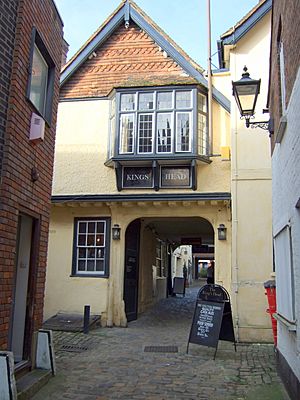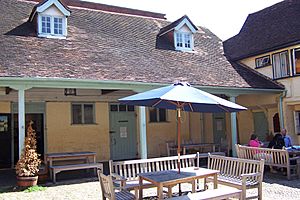King's Head Inn, Aylesbury facts for kids
The King's Head is one of the oldest inns with a coaching yard in the south of England. It is located in Market Square, Aylesbury, Buckinghamshire. This historic building is officially recognized as a Grade II* Listed Building, meaning it's very important.
The oldest part of the building you see today was built in the 1400s. However, its cellars are even older, dating back to the 1200s. These cellars might have been part of a local friary, which was a type of monastery.
Contents
A Look Back in Time
The story of The King's Head began in 1455. The first written record of the inn appeared in a document from that year. It mentioned the newly built 'Kyngeshede,' along with a cellar, a shop, and some small houses. The Great Hall is the oldest part of the building still standing. It was built around the 1470s as a guest house by the Verney family, who lived nearby.
It's possible that King Henry VI stayed at the inn in the 1400s. He was on a trip around the country with his new wife, Margaret of Anjou. Later, a special stained glass window was put into the front of the inn. This window came from a nearby monastery. It shows the king and queen's family symbols, called coats of arms. Other coats of arms on the window belong to important people from that time. This window is still there today, carefully protected.
From the mid-1600s, The King's Head became a very busy coaching inn. This meant it was a place where horse-drawn carriages, called stagecoaches, would stop. Travelers could rest, eat, and change horses. The front entrance is smaller than the back one. The back entrance was made wider to fit the bigger carriages. You can still see special stones at the entrance. These stones helped guide the carriage wheels as they came in.
Around 1750, the innkeeper, William Bell, changed the small houses into part of the public house. This made more room for stagecoaches. He also added more stables in the courtyard. These stables could hold almost thirty horses. A metal hoop above a mounting block was used to light the way for coaches. Rags were tied around it and set on fire. The walls of the inn are covered in a special lime wash. This lets the wood breathe and stops it from rotting. Over time, the wood will show through more as the lime wash wears away.
The English Civil War
During the English Civil War (around the 1640s), Aylesbury supported the Parliamentarians. These were the people fighting against King Charles I. It's very likely that Parliamentarian soldiers visited The King's Head. Some people believe that Oliver Cromwell, a famous Parliamentarian leader, was in Aylesbury around 1650. However, there is no clear proof that he stayed at The King's Head.
There's a story that the inn is connected to other buildings in town by secret underground tunnels. People thought these tunnels were used as escape routes during the Civil War. But there's no real proof of these tunnels. It's more likely that these "tunnels" are just old cellars.
After the English Civil War, there weren't enough coins. So, inns like The King's Head started making their own special coins called trade tokens. William Dawney, who was the innkeeper in 1657, made these tokens. They could be used as money. You can see copies of these tokens on display at the inn.
How the Inn Was Built
In the Great Hall, you can see how the walls were made using a method called wattle and daub. Wattle was made from twigs and branches woven together between upright wooden posts. Daub was a mix of clay, lime, and horsehair. This mix was pushed into the wattle frame to create a strong, weatherproof wall.
Special Things to See
A rare clock hangs on the wall. It's called a Tavern clock, or sometimes an Act of Parliament clock. In 1797, a tax was put on all clocks and watches. Because of this, public clocks like the one at the inn became very popular for people to check the time. The bar area was added by the Rothschild family. They bought the property as a hotel in the 1800s. In a small, cozy room next to the bar, you can see an example of Victorian-era wallpaper. This type of wallpaper would have covered the whole room back then.
In the late 1600s, The King's Head started receiving mail. Horsemen would drop the mail through a special opening behind the mirrors. This room is called the 'Glue Pot' because mail was once sorted and stamped here. Below some old meat hooks, there's a square patch on the wall. This is where the hole for the mail would have been. It was just the right height for mail to be delivered by someone on horseback. The cobbled path outside leads into the courtyard. This courtyard dates back to the early 1300s and was once the original market square. There are three layers of cobblestones, showing how old it is.
Ghost Stories
The King's Head is said to have at least three ghosts. One is called The Grey Lady. People say she stands by the fireplace in the Great Hall. Another ghost has been seen in the corridor near the red staircase. It's thought to be a maid who sadly fell to her death around 1900.
The Rooms of the Inn
The Georgian Room
The Georgian Room gets its name from the style of the wooden panels on its walls. These panels were made between 1714 and 1837. On the wall, you can see a Hussar's belt and satchel. These belonged to the Royal Bucks Hussars, a type of mounted soldier from the 1800s. The belt would have held a decorative sword. The satchel is decorated with silver braid and has the letters 'VR' (for Queen Victoria) with a crown in the middle.
The Gatehouse Chamber
One of the most impressive rooms at The King's Head is the Gatehouse Chamber. This room dates back to the mid-1500s. In the 1600s, courts met here to decide criminal cases. Judges would announce their decisions from the front window of this room. This window would have looked out over the Market Square. Being on the first floor gave the judge importance and kept them safe from angry crowds. A well-known judge named George Jeffreys visited the King's Head. In 1700, local leaders thought about turning The King's Head into an extra jail. But it would have cost too much money to fix it up.
The most important part of the room is its ceiling. It was designed by an architect named George Devey in the 1880s. The Rothschild family hired him to make changes to The King's Head. He moved the front window slightly to keep the view of the Market Square. He also redesigned the ceiling in a style that looked like Tudor buildings. He used some of the original wooden beams. However, the black and white design was a Victorian idea of how Tudor buildings looked. Real Tudor rooms could actually be very colorful. The large old fireplace was moved here from the Great Hall. It has carvings on it, possibly made by soldiers during the English Civil War.
The Solar Room
The Solar Room is directly above the Great Hall. It was once the main bedroom. Local stories say that King Henry VIII met Anne Boleyn in this room in 1533. It's also claimed that Oliver Cromwell stayed at the King's Head in 1651 after a battle. He supposedly received thanks from Parliament in Market Square. However, there is no proof of this. But if Cromwell did stay here, this would have been his room. Old pistols and swords were found earlier in the 1900s in a "priest hole." This was a secret hiding place. These finds suggest that soldiers were once staying at the property. The roof of the room is Victorian, except for some original wooden beams in the back wall. The room was originally reached by a spiral staircase from the ground floor.
The Dining Room
The Dining Room was built in the late 1800s when The King's Head was a hotel. George Devey added the oak panels to the walls. The room originally had two fireplaces. In November 2003, the ghost of a nun was seen here. The nun had been seen before, but only by ladies. The dining room itself was built on land that once belonged to a church or friary.
The National Trust
After being a hotel for many years as part of the Rothschild family's businesses, the property was given to the National Trust in 1925. A special plaque at the inn remembers this event. The National Trust is working to make the inn a central place for the Aylesbury community. Visitors can still go to the inn today and buy drinks, just like at any other pub.
The pub inside The King's Head, called The Farmers' Bar, has been managed by The Chiltern Brewery since 2005.



